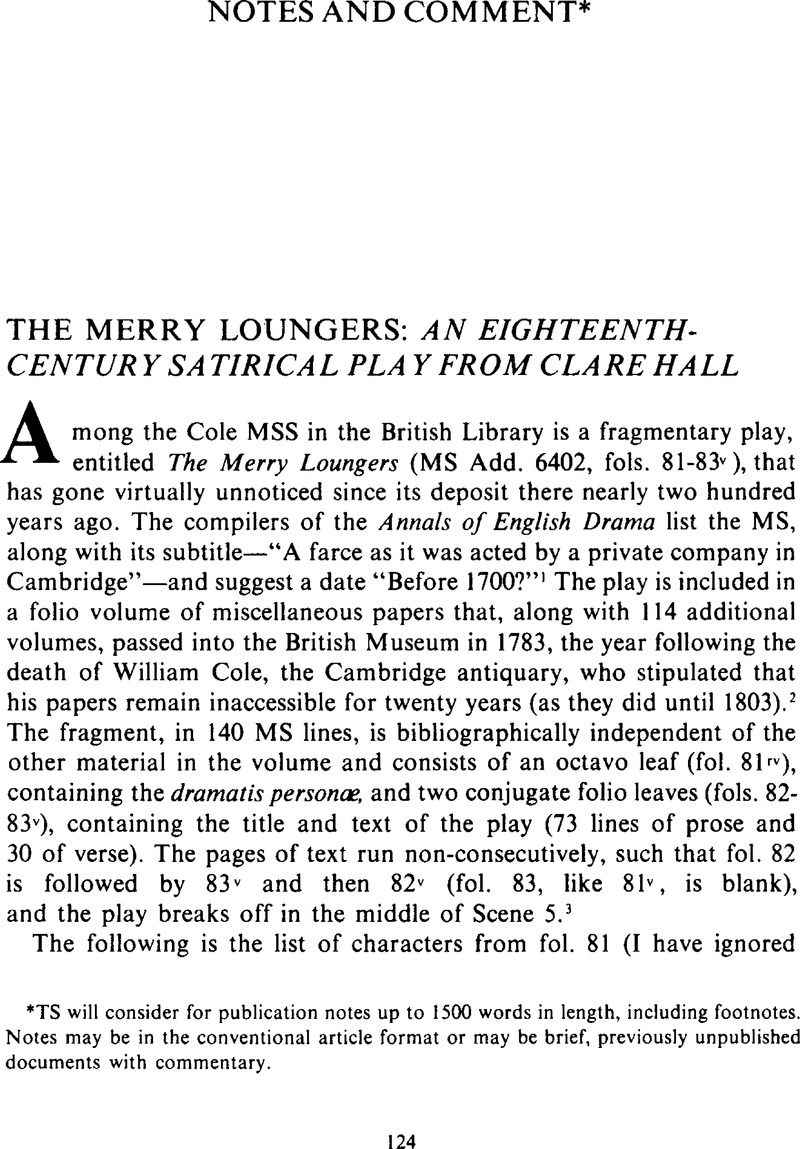No CrossRef data available.
Article contents
The Merry Loungers: An Eighteenth-century Satirical Play From Clare Hall*
Published online by Cambridge University Press: 07 July 2009
Abstract

- Type
- Notes and Comment
- Information
- Copyright
- Copyright © American Society for Theatre Research 1979
References
1 Harbage, Alfred, Annals of English Drama 975–1700, rev. Schoenbaum, S. (London: Methuen, 1964), pp. 203, 319Google Scholar.
2 Cooper, Thompson, “Cole, William,” DNB (1887)Google Scholar.
3 Fol. 82 contains a watermark of the “Pro Patria” type, and fol. 83 has an “anchor” counterfoil. The three leaves have earlier foliations, 84–86 (in red) and 82–84. The handwritten catalogue in the Students' Room of the British Library identifies the fragment as article 27 of MS. Add. 6402: “Dramatis Personae, with a Satyrical Play, entitled The Merry Loungers, fol. 84[–86v]” (A Catalogue of the Additions made to the Library of Manuscripts in the British Museum since the Publication of M' Ayscough's Catalogue, IV [1820], 128)Google Scholar.
4 Alumni Cantabrigienses.… Part I, comp. Venn, John and Venn, J. A., 4 vols. (Cambridge: Cambridge Univ. Press, 1922–1927), IV, 9Google Scholar; Norgate, Gerald Le Grys, “Salter, Samuel,” DNB (1897)Google Scholar. His father was Archdeacon Samuel Salter (d. 1756), also of Corpus Christi College; Cole observed of the younger Salter that he “was one of the tallest men I have seen” (Nichols, John, Literary Anecdotes of the Eighteenth Century, 9 vols. [London, 1812–1815], IX, 787)Google Scholar.
5 Alumni Cantab., II, 465Google Scholar.
6 Alumni Cantab., I, 212Google Scholar.
7 Alumni Cantab., IV, 371Google Scholar.
8 Alumni Cantab., III, 423Google Scholar.
9 Alumni Cantab., IV, 264Google Scholar.
10 Alumni Cantab., III, 457Google Scholar.
11 Alumni Cantab., II, 370–371Google Scholar; Hamilton, John Andrew, Lord Sumner of Ibstone, “Hill, George,” DNB (1891)Google Scholar.
12 Alumni Cantab., I, 368Google Scholar; DNB.
13 Alumni Cantab., II, 214Google Scholar.
14 I am unable to identify Nichols, but Trevigar also mentions “lawry,” probably John Lawry (d. 1773), who was admitted at Clare on 31 May 1732, matriculated the same year, and received his B.A. in 1735 (Alumni Cantab., III, 54Google Scholar).
15 “Benno's court” was perhaps named after Edward Benlowes, the Cambridge benefactor (see Bullen, A. H., “Benlowes, Edward,” DNB [1885–1886])Google Scholar.
16 Shakespeare, William, The Complete Works, ed. Harbage, Alfred, The Pelican Text Revised (Baltimore: Penguin Books, 1969), pp. 677, 1133, 941Google Scholar.
17 Milton, John, Complete Poems and Major Prose, ed. Hughes, Merritt Y. (Indianapolis: Odyssey Press, 1957), p. 218Google Scholar.
18 The Spectator, ed. Bond, Donald F., 5 vols. (Oxford: Clarendon, 1965), I, 229Google Scholar, where Steele's correspondent is identified as Lawrence Eusden; see also p. 336 (Spectator No. 78, 30 May 1711)Google Scholar.
19 SirChambers, Edmund, The Elizabethan Stage, 4 vols. (Oxford: Clarendon, 1923), III, 475–476; IV, 5–6Google Scholar; and Bentley, Gerald Eades, The Jacobean and Caroline Stage, 7 vols. (Oxford: Clarendon, 1941–1968), V (1956), 1027–1028Google Scholar.




